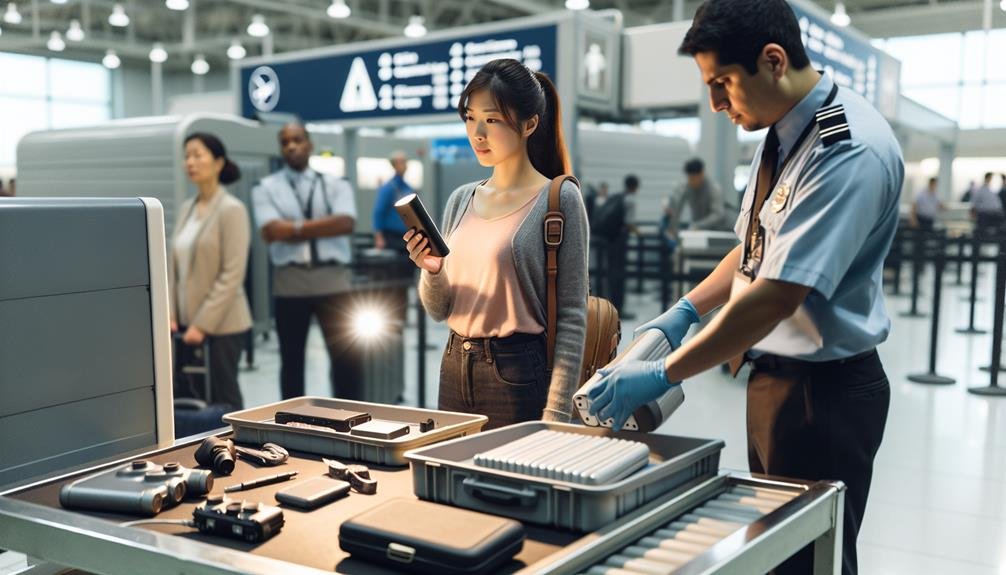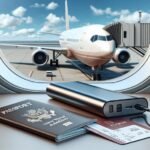Yes, you can bring power banks on a plane, but only in your carry-on luggage. They're prohibited in checked bags due to safety risks. Most airlines follow IATA guidelines, allowing power banks up to 100Wh without approval. If it's between 100-160Wh, you'll need airline consent, and anything over 160Wh isn't permitted. Make sure your power bank's watt-hour rating is clearly labeled. Avoid charging it during the flight to comply with regulations. Each airline may have specific rules, so it's important to check those beforehand. Continue for detailed guidelines and travel tips.
Airline Regulations Overview
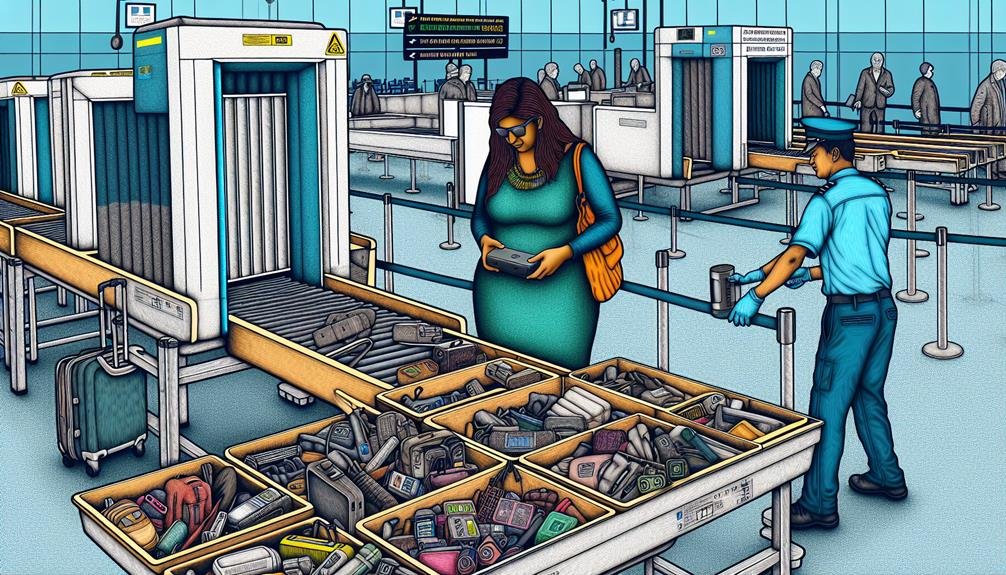
When traveling with power banks, it's essential to understand the airline regulations that govern their transport to guarantee compliance and safety. Airline carriers adhere to both domestic and international regulations designed to minimize risks associated with lithium-ion batteries. You'll need to familiarize yourself with these safety guidelines to make sure your journey is smooth and hassle-free.
First, be aware of the power bank restrictions that apply to air travel. Most airlines follow rules set by the International Air Transport Association (IATA), which mandates that power banks must be carried in carry-on luggage. Power banks with a capacity of up to 100 watt-hours (Wh) are generally allowed without prior approval, while those between 100 and 160 Wh may require airline permission. Devices exceeding 160 Wh are typically prohibited.
It's important to check the specific regulations of the airline you're flying with, as they can vary. Some carriers impose stricter rules than others. Always include your power banks in your travel essentials checklist, making sure they're within the allowed capacity limits and properly labeled. By following these international regulations and safety guidelines, you can mitigate risks and ensure compliance during your flight.
Carry-On Vs. Checked Luggage
Understanding whether power banks should be placed in carry-on or checked luggage is crucial for adhering to airline safety regulations and minimizing travel disruptions. Power banks, due to their lithium-ion batteries, pose specific safety concerns. They should always be stored in your carry-on luggage rather than checked baggage. This precaution is important because, in the rare event of a thermal runaway (an uncontrolled increase in temperature), the flight crew can immediately address the issue, ensuring everyone's safety.
When considering storage options, remember that placing power banks in checked luggage is strictly prohibited by most airlines. This restriction is in place because the cargo hold is not easily accessible during a flight, making it challenging to mitigate any risks associated with battery malfunctions. Additionally, the pressurized cabin environment of carry-on areas is better suited for maintaining the charging capabilities and battery life of your power banks.
Allowed Power Bank Capacity
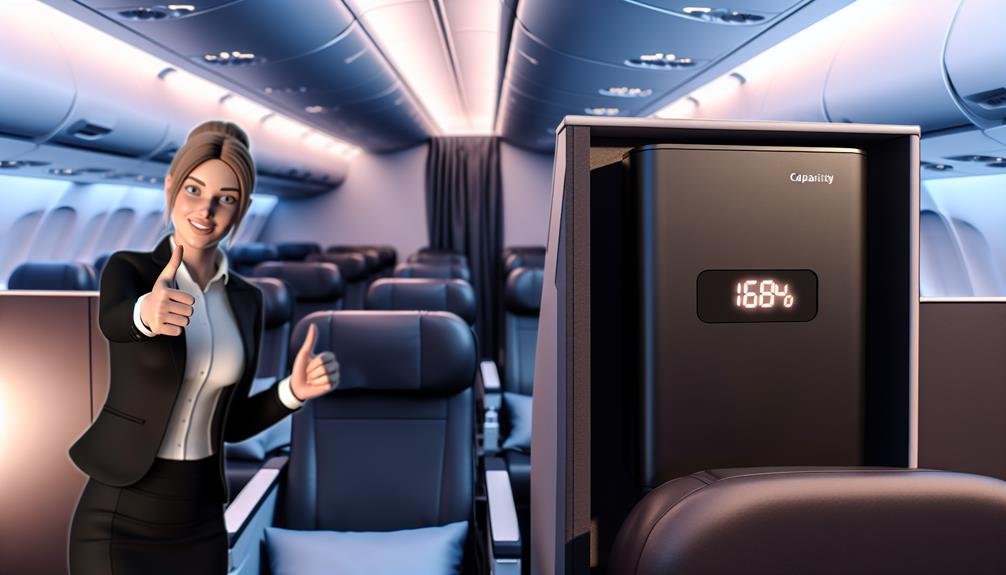
Most airlines regulate the capacity of power banks you can carry, typically capping it at 100 watt-hours (Wh) without prior approval. This restriction stems from the need to minimize risks associated with lithium-ion batteries, which can pose fire hazards if damaged or improperly stored.
When considering which power banks to pack, you should be aware of the following:
- Power bank size: Make sure the capacity doesn't exceed 100 Wh, roughly equivalent to 27,000 mAh for a 3.7V battery.
- Multiple devices: If you need larger capacities, airlines may allow up to two power banks between 100 and 160 Wh, but you'll usually need airline approval.
- Visible labeling: Power banks must clearly display their watt-hour rating or voltage and amp-hour details for easy calculation and verification.
Adhering to these travel regulations guarantees compliance with airline policies and enhances overall flight safety. Failing to observe power bank restrictions could lead to confiscation at security checkpoints or even potential fines. Always check the specific airline policies before your trip, as they can vary slightly between carriers. By staying informed, you're contributing to a safer travel environment for everyone on board.
Lithium-Ion Battery Restrictions
When you're traveling with power banks, it's critical to understand the restrictions placed on lithium-ion batteries. Each airline has specific capacity limits, and regulations typically require these batteries to be in your carry-on, not checked luggage. Securing compliance with these rules mitigates the risk of fire hazards and guarantees a seamless travel experience.
Capacity Limits
Finding your way through airline regulations involves understanding the capacity limits for lithium-ion batteries in power banks to guarantee compliance and safety during flights. Airlines adhere to strict capacity restrictions to mitigate risks associated with high-energy batteries. Typically, power banks with a capacity over 100Wh (watt-hours) require airline approval, while those exceeding 160Wh are generally prohibited.
To guarantee safety, follow these measures:
- Capacity Restrictions: Verify your power bank's watt-hour rating; it's usually printed on the device. If it's not visible, calculate it using the formula: (mAh/1000) * Voltage (V).
- Storage Options: Always store power banks in your carry-on luggage. Storing them in checked baggage is prohibited due to the risk of overheating or fire.
- Charging Guidelines: Avoid charging power banks while on the plane to prevent overheating. Use them only when necessary and adhere to the airline's specific charging policies.
Awareness of these regulations not only assures compliance but also prioritizes the safety of passengers and crew. By adhering to capacity restrictions and following appropriate storage options and charging guidelines, you contribute to a safer flight environment for everyone.
Carry-On Rules
Understanding the carry-on rules for lithium-ion batteries is vital to guarantee compliance with airline safety regulations and mitigate the risks associated with these high-energy devices. Lithium-ion batteries, commonly found in portable chargers, pose a significant fire risk if damaged or improperly handled. That's why strict guidelines exist to safeguard these items are safely transported in the cabin.
Airline policies generally mandate that lithium-ion batteries, including those in portable chargers, must be carried in your carry-on baggage. This is to enable the flight crew to quickly address any issues that may arise during the flight. Most airlines allow power banks with a capacity of up to 100 watt-hours (Wh) without prior approval. For power banks between 100 and 160 Wh, you'll need airline approval, and typically, you can only bring a limited number of these.
To comply, you should always check the watt-hour rating printed on your portable charger. If it's not listed, you can calculate it using the formula: (mAh/1000) x Voltage = Wh. Always pack your power bank in a manner that prevents accidental activation and short-circuiting, such as using a protective case. Adhering to these guidelines will guarantee your journey remains safe and hassle-free.
Packing Tips for Power Banks
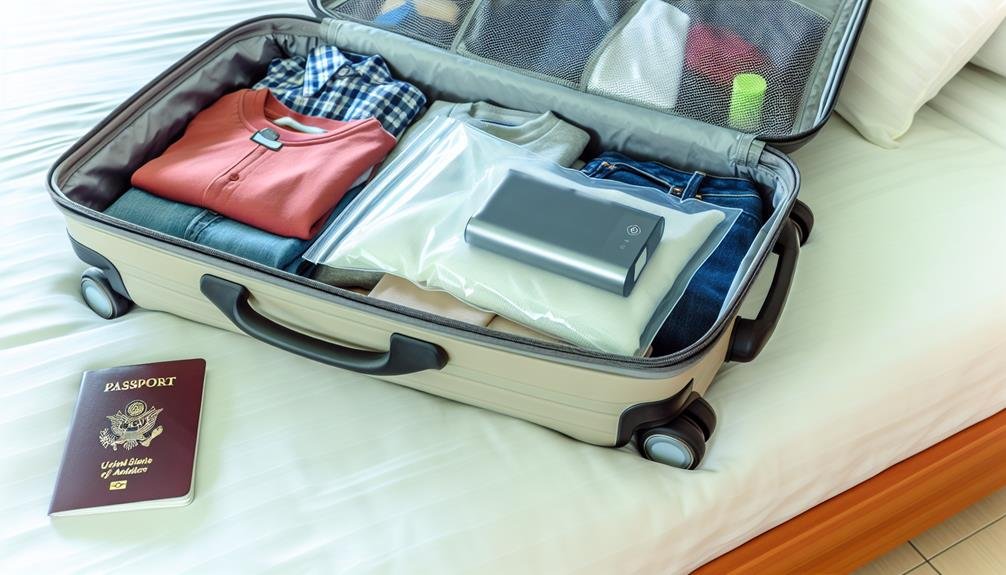
Proper packing of power banks is essential to guarantee compliance with airline regulations and to mitigate any potential safety risks during your flight. First and foremost, you should be aware of the charging etiquette and battery life of your power bank. Ensuring your power bank is fully charged before traveling helps you avoid the need for charging in-flight, which can sometimes be restricted.
Make sure to:
- Use protective cases: Place your power bank in a durable case to prevent accidental activation and physical damage. This helps to avoid short circuits and potential hazards.
- Separate from other electronics: Keep your power bank in a separate compartment of your carry-on bag to reduce the risk of interference with other devices and to make it easily accessible during security checks.
- Check the watt-hour rating: Verify that the power bank's watt-hour (Wh) rating complies with airline limits. Usually, power banks under 100 Wh are allowed without prior approval, but always check your airline's specific guidelines.
International Travel Considerations
When traveling internationally, you'll need to be aware that airline regulations for power banks can vary greatly. It's important to check the specific battery capacity limits set by each airline to guarantee compliance. Failing to do so might result in confiscation or fines, posing a risk to your travel plans.
Airline Regulations Vary
Different airlines have distinct regulations regarding power banks, especially on international flights. While TSA guidelines provide a baseline for what's allowed, individual airline policies can vary significantly. It's essential to check with your airline before departure to avoid any surprises at the gate.
When considering international travel, you need to be aware of differing rules that could affect your journey. For instance:
- Carry-on vs. Checked Luggage: Some airlines permit power banks in carry-on baggage only, prohibiting them in checked luggage altogether.
- Approval Requirements: Certain carriers may require pre-approval for high-capacity power banks, necessitating advance notice and documentation.
- Country-Specific Regulations: Various countries impose their own restrictions on battery-powered devices, which airlines must comply with.
These variations highlight the importance of understanding both TSA guidelines and airline policies to ensure a smooth travel experience. Familiarize yourself with the specific requirements of each airline you'll be flying with. By doing so, you reduce the risk of having your power bank confiscated or facing delays. Always prioritize safety and regulatory compliance to make your trip stress-free.
Battery Capacity Limits
Understanding the battery capacity limits is crucial as you navigate international travel regulations for power banks. Most airlines have strict rules due to safety guidelines surrounding lithium-ion batteries. Typically, power banks with a capacity of up to 100Wh (watt-hours) are generally allowed without prior approval. For capacities between 100Wh and 160Wh, you'll need the airline's consent. Anything over 160Wh is usually prohibited in both checked and carry-on baggage.
When planning your trip, check the specific airline restrictions well in advance. These rules can vary significantly between airlines and countries. Familiarize yourself with the power bank capacity limits to avoid confiscation during security checks. Most power banks display their capacity in mAh (milliampere-hours), so you may need to convert this to watt-hours (Wh) by multiplying the voltage (V) by the capacity (mAh) and then dividing by 1000.
Security checks are rigorous, and non-compliance with these safety guidelines can result in delays or penalties. Knowing the regulations and preparing accordingly ensures a smoother travel experience. Always pack your power banks in your carry-on luggage and be ready to declare them during security screening.
Airport Security Procedures
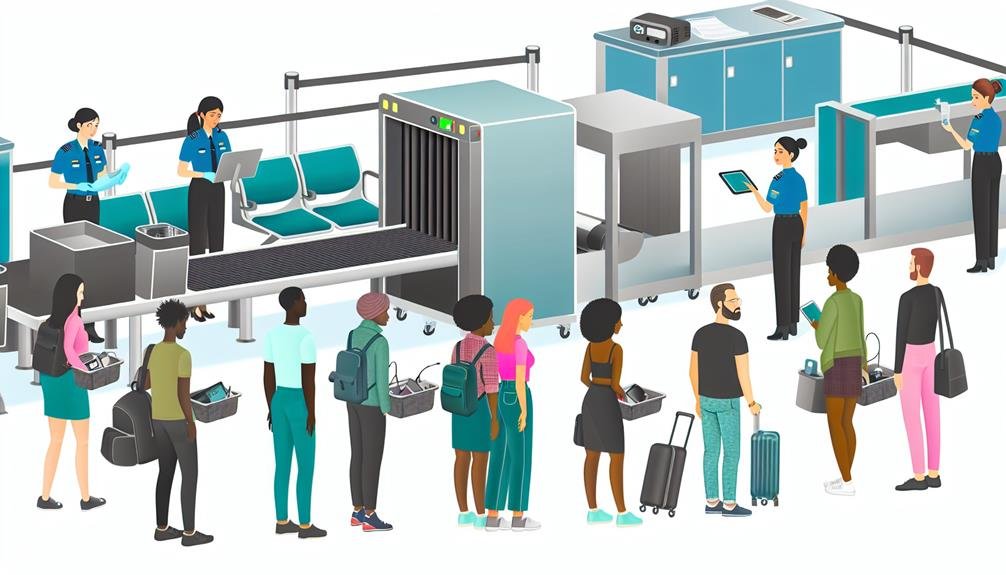
Understanding airport security procedures for power banks requires an understanding of both regulatory guidelines and potential safety risks. When you approach the security checkpoint, you'll need to make sure your power banks are properly packed and ready for X-ray screening. Security personnel will scrutinize these devices closely to mitigate any potential hazards.
To make your experience smoother, remember:
- Place power banks in your carry-on luggage: Never pack them in checked luggage due to the risk of battery fires.
- Adhere to watt-hour limits: Most airlines allow power banks up to 100Wh without prior approval, but always check specific airline regulations.
- Separate power banks for screening: Just like laptops, power banks should be taken out of your bag and placed in a tray for individual X-ray screening.
The X-ray screening process is designed to identify any unusual items or configurations that could pose a threat. By following these guidelines, you help make sure the safety of everyone on board. Regulatory compliance isn't just about following rules; it's about understanding the reasons behind them and prioritizing safety. Stay informed and proactive, and your journey through the security checkpoint with power banks will be smooth and secure.
Traveling With Multiple Devices
Navigating airport security becomes even more intricate when you're traveling with multiple devices, demanding thorough preparation and adherence to regulations to secure a smooth process. To start, you must address device compatibility and charging needs. Different devices may necessitate various types of connectors and voltage levels. Prioritize a universal power bank that supports multiple output ports and has the capability to charge multiple devices simultaneously.
Being aware of power bank size and weight restrictions is also crucial. Most airlines allow power banks with a capacity of up to 100 watt-hours (Wh) in carry-on luggage, while those between 100-160 Wh usually require airline approval. Power banks exceeding these limits are generally prohibited. Additionally, weight restrictions can impact your packing strategy, as lighter power banks are easier to manage and less likely to flag security concerns.
Conduct a risk assessment by checking the airline's specific guidelines on electronic devices and power banks. This ensures you're not caught off guard at security checkpoints. By thoroughly planning your device compatibility and observing power bank size and weight restrictions, you mitigate potential disruptions, guaranteeing a safer and more efficient travel experience.
What to Do if Confiscated
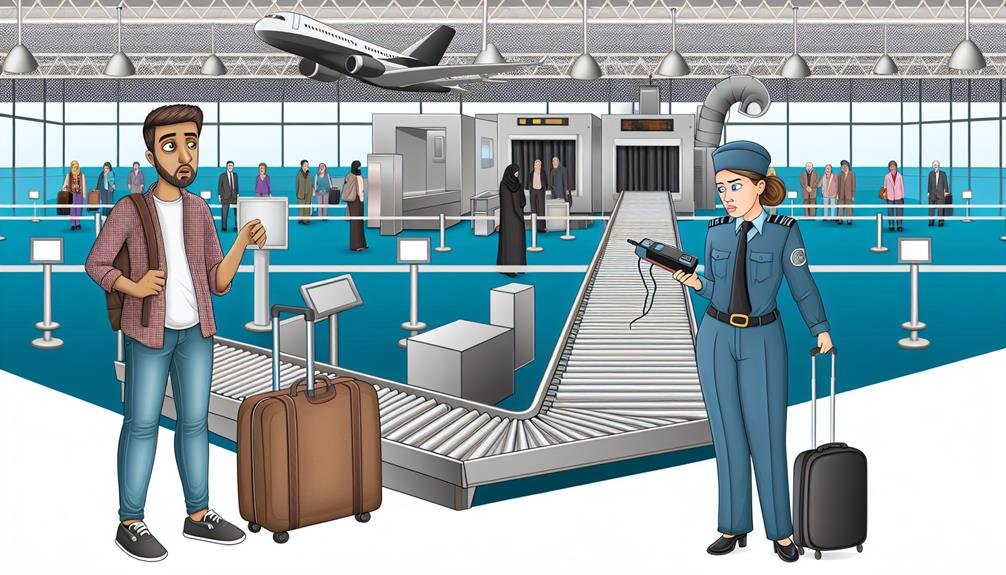
If your power bank is confiscated at airport security, immediately inquire about the specific reason for its seizure to grasp the regulatory breach. Knowledge of the exact violation will help you align your future actions with airport regulations. Typically, confiscation occurs due to electronic device restrictions related to watt-hour ratings or improper packaging.
To increase the likelihood of reclaiming confiscated items, follow these steps:
- Consult Airport Lost and Found: Check if your power bank has been logged in the lost and found registry.
- Contact Airline Customer Service: Airlines often have procedures to assist passengers in reclaiming confiscated items.
- File a Claim: Submit a formal claim if the item is essential and valuable.
Understanding security procedures can aid in avoiding future issues. Remember, certain high-capacity power banks are banned due to the risk they pose in the aircraft cabin. Always verify the watt-hour rating and verify it complies with the airline's guidelines.
Frequently Asked Questions
Can I Use My Power Bank During the Flight?
During a recent flight, a passenger was asked to stop using their power bank due to its high battery capacity. Always check charging etiquette and airline regulations, and guarantee your device's capacity complies with safety standards.
Are Solar-Powered Power Banks Subject to the Same Rules?
Yes, solar-powered power banks are subject to the same rules. Confirm solar panel efficiency and battery capacity meet airline regulations. Always check battery capacity limits and pack your power bank in carry-on luggage for safety.
Do I Need to Declare My Power Bank at the Check-In Counter?
You might wonder, during the check-in process, if you need to declare your power bank. While it's not mandatory, airport security will scrutinize your power banks. Ensuring compliance with regulations minimizes risks and enhances safety.
How Can I Check the Watt-Hour Rating of My Power Bank?
To check the watt-hour rating of your power bank, look for the label displaying mAh and voltage. Multiply these values and divide by 1,000. Ensuring power bank safety and compliance with airline regulations is essential for travel safety.
Are Power Banks Allowed in All Countries?
When considering customs regulations and international travel restrictions, you'll find that power banks aren't universally allowed in all countries. Always check each destination's guidelines to guarantee compliance and safeguard your safety during travel.

